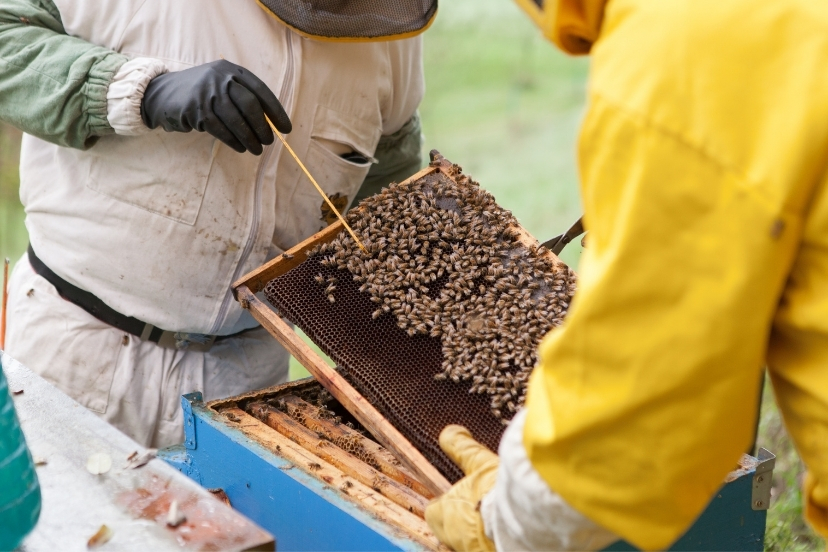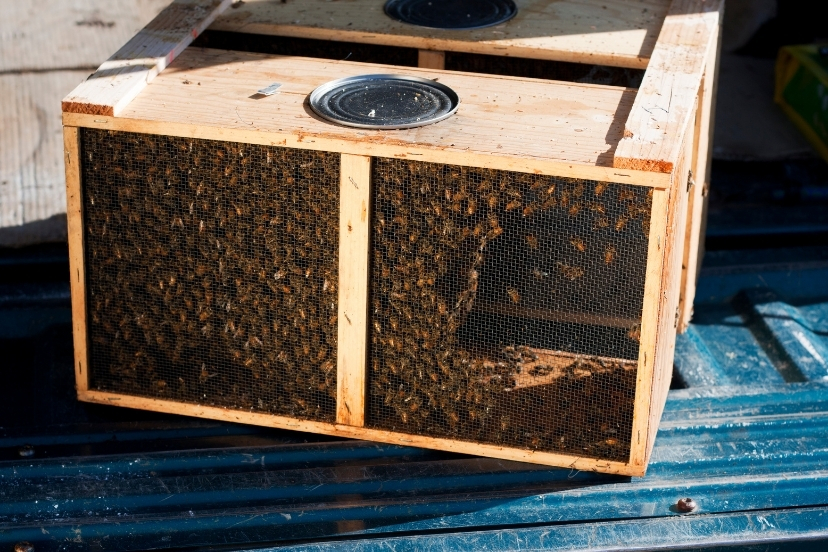I’ve spent over 15 years studying and working with honeybees, and I’m still amazed by their complex communication systems. Let me tell you, there’s nothing quite like watching a colony work in perfect harmony, all thanks to their incredible ability to share information.
Today, I’m going to break down everything I’ve learned about how these fascinating creatures talk to each other.

- The Evolution of Bee Communication
- The Role of Pheromones in Communication
- Role of the Queen in Hive Communication
- The Famous Waggle Dance: Nature's GPS System
- Round Dance and Other Movement-Based Communications
- Vibrational Communication Methods
- Visual Signals Among Bees
- Alarm Signals and Defense Mechanisms
- Communication During Foraging
- Colony-Wide Communication Networks
- Swarm Behavior and Leadership Signals
- Environmental Influences on Communication
- Human Understanding of Bee Communication
The Evolution of Bee Communication
When I first started keeping bees, I had no idea just how sophisticated their communication methods were. Over millions of years, honeybees have developed an intricate language that combines chemical signals, movement patterns, and even vibrations.
It’s mind-blowing to think that these tiny insects have evolved such complex ways of sharing information that we’re still trying to fully understand. Recent research suggests that bee communication may have evolved from simple food-sharing behaviors to the complex system we see today.
The Role of Pheromones in Communication
Let me tell you about the time I first learned about bee pheromones – it completely changed how I viewed these insects. Pheromones are essentially chemical messengers that bees use to communicate everything from danger to food locations.
The queen bee alone produces multiple types of pheromones that regulate colony behavior. During one particularly challenging hive inspection, I noticed how quickly alarm pheromones spread through the colony when I accidentally crushed a bee. Within seconds, the entire hive was on alert.
Key pheromones and their functions:
- Queen mandibular pheromone maintains colony cohesion and prevents worker egg-laying
- Brood pheromones signal the needs of developing larvae and regulate nurse bee behavior
- Nasanov pheromones help bees locate their hive and orient returning foragers
- Alarm pheromones warn of dangers and coordinate defensive responses
- Forager pheromones indicate successful food source locations
- Worker pheromones help regulate division of labor within the hive
Role of the Queen in Hive Communication
The queen bee isn’t just a laying machine – she’s the heart of all colony communication. Through her pheromones, she maintains order and lets workers know she’s alive and healthy. I remember one time when I had a queenless colony; the change in behavior was dramatic. Without those queen pheromones, the workers became noticeably agitated, and some even started laying eggs (though unfertilized).
Queen communication signals include:
- Queen substance that prevents worker ovary development
- Footprint pheromones that mark her path through the hive
- Egg-marking pheromones that identify her eggs as legitimate
- Retinue attraction pheromones that gather workers to care for her
- Swarm suppression signals that prevent premature colony division
The Famous Waggle Dance: Nature’s GPS System
Now, here’s where things get really interesting. The waggle dance is hands-down one of the most sophisticated communication systems in nature. I’ve spent countless hours watching forager bees perform this incredible dance on the honeycomb.
The dance literally tells other bees the exact location of food sources relative to the sun and hive. What’s even more fascinating is how precise this communication is – bees can indicate food sources up to 6 kilometers away with remarkable accuracy!
Components of the waggle dance:
- Dance angle relative to vertical indicates direction relative to the sun
- Duration of waggle run indicates distance to food source
- Vigor of the dance shows quality and abundance of the food
- Number of dance repetitions indicates the source’s importance
- Wing vibrations during the dance provide additional information
- Dance followers use antennae to detect subtle movements
Round Dance and Other Movement-Based Communications
Besides the waggle dance, bees use other movement patterns to communicate. The round dance, which I often see in my observation hive, is used for nearby food sources – typically within 50 meters of the hive.
It’s basically a circular dance that says, “Hey, there’s good food really close by!” I’ve noticed that the more excited the dancer, the better the food source usually is.
Vibrational Communication Methods
One of the lesser-known aspects of bee communication is their use of vibrations. Bees actually create specific vibration signals by pressing their bodies against the comb and buzzing their flight muscles.
I’ve felt these vibrations myself when holding frames – it’s like a tiny massage! These signals can indicate everything from the need to swarm to telling house bees to feed foragers.
Different types of vibration signals:
- Dorsoventral abdominal vibrations for activating worker bees
- Stop signals to regulate foraging activity
- Queen piping to establish dominance
- Worker piping to prepare for swarming
- Tooting and quacking between virgin queens
- Shaking signals for various social interactions
Visual Signals Among Bees
While bees don’t rely primarily on visual signals within the dark hive, they do use visual cues during flight and foraging. The patterns on flowers, for instance, are like runway lights guiding bees to nectar sources.
I’ve watched bees follow these ultraviolet patterns that are invisible to human eyes but clear as day to them. Recently, researchers have discovered that bees can even recognize individual human faces, which shows just how sophisticated their visual processing abilities are.
Alarm Signals and Defense Mechanisms
Having been stung more times than I care to count, I’ve become quite familiar with bee defense communication! When a bee stings, it releases alarm pheromones that alert the colony to danger.
This creates a cascade effect – one defensive bee can quickly rally others to protect the hive. I’ve learned the hard way that wearing dark colors or making quick movements can trigger this defense response.
Defense communication includes:
- Release of alarm pheromones from sting apparatus
- Guard bee warning signals to returning foragers
- Defensive flight patterns to intimidate intruders
- Coordinated attack responses
- Heat-balling behavior against predatory wasps
- Recognition signals between guard bees
Communication During Foraging
Foraging communication is like a well-orchestrated dance (literally!). Beyond the waggle dance, foragers share information about food quality through trophallaxis – the sharing of nectar samples.
I’ve observed how bees who’ve found high-quality nectar sources tend to share their samples more enthusiastically, encouraging more foragers to visit that location.
Colony-Wide Communication Networks
Think of a bee colony as the internet – information flows constantly in all directions. Young bees learn from older bees, foragers communicate with guards, and everyone responds to the queen’s signals.
It’s fascinating how a colony of thousands can work so seamlessly together. I’ve seen this network in action during swarm preparation, where the entire colony seems to know what’s coming before it happens.
Swarm Behavior and Leadership Signals
Speaking of swarming, this is where bee communication really shines. Before a swarm leaves, scout bees perform an intricate democracy process to choose a new home.
They use movement patterns, pheromones, and even head-butting signals to debate and decide on the best location. I once watched this process unfold over several days – it was like witnessing a tiny election campaign!
Key swarm communication signals:
- Scout bee dances for potential new home sites
- Vibration signals to prepare for departure
- Queen readiness signals
- Worker preparation signals
- Timing coordination signals
- Directional guidance during flight
Environmental Influences on Communication
Weather conditions, time of day, and seasonal changes all affect how bees communicate. On cloudy days, for instance, bees have to adjust their waggle dance to account for the hidden sun.
Temperature affects pheromone distribution, and seasonal changes influence the types of messages being shared. During one particularly hot summer, I noticed my bees using more ventilation signals to coordinate colony cooling.
Environmental factors affecting communication:
- Temperature impact on pheromone dispersal
- Light levels affecting dance precision
- Wind conditions altering foraging signals
- Seasonal changes in communication priorities
- Humidity effects on chemical signal transmission
- Time of day influences on dance accuracy
Human Understanding of Bee Communication
We’ve come a long way in understanding bee communication since Karl von Frisch first decoded the waggle dance (and won a Nobel Prize for it!). But there’s still so much to learn. Modern research using artificial intelligence and advanced sensors is revealing new aspects of bee communication almost yearly. It’s humbling to think that after all these years of study, these tiny insects still have secrets to share.
The future of bee communication research is incredibly exciting. Scientists are discovering new pheromones and signals regularly, and our understanding of how bees process and share information keeps growing. As someone who’s spent years working with these remarkable insects, I can tell you that every new discovery just makes them even more fascinating.
Remember, when you’re watching bees buzz around your garden, you’re not just seeing random insects – you’re witnessing one of nature’s most sophisticated communication networks in action. The more we understand about how bees communicate, the better we can protect them and ensure their continued survival in our changing world.


